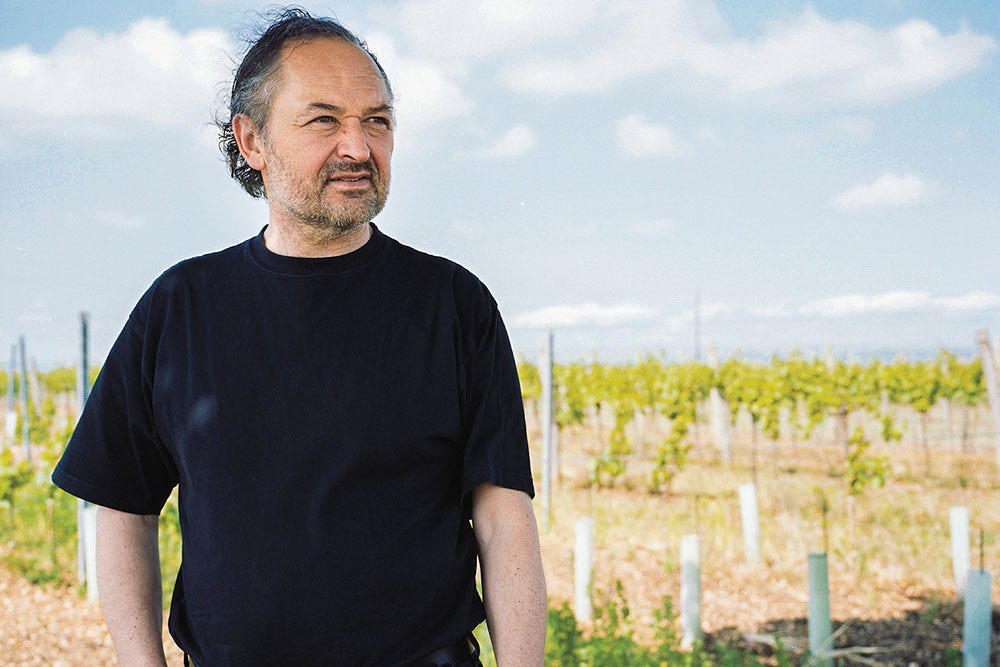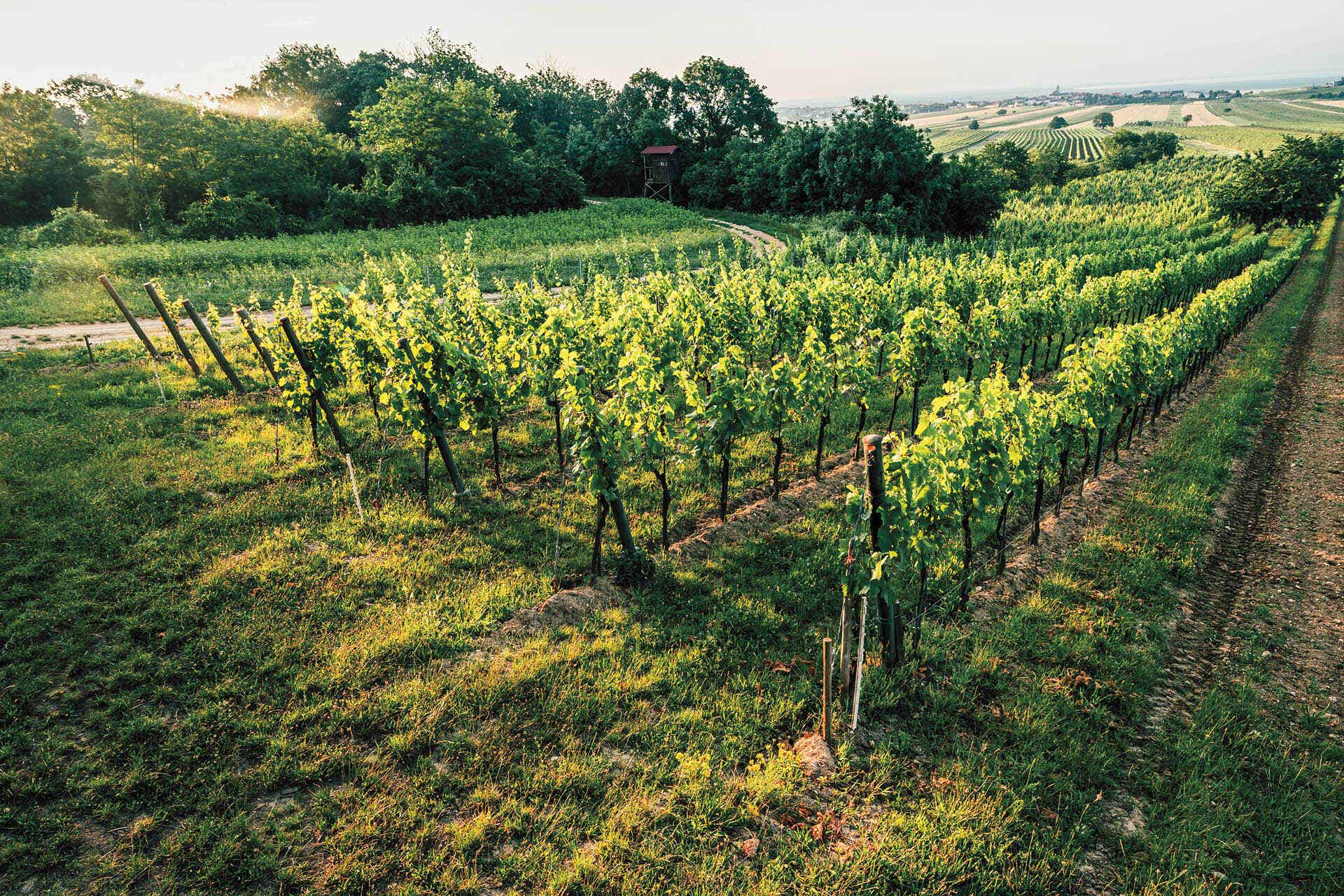Why Hungary Is Betting on Furmint to Help Combat Climate Change

The year was 1984. The Iron Curtain still had a stronghold on Europe, casting its shadow on anything east of the Austro-Hungarian border. Robert Wenzel, a grape grower in the Burgenland region of Austria, made the potentially dangerous trek to Hungary to bring back cuttings of Furmint. The idea was to revive what was once the most popular white grape variety in his village of Rust. Robert had permission from Austrian authorities but not from the communist Hungarians.
At that time, crossing the border took several hours. Robert’s father, who was in the car with him, tried to break the tedium by playing his tárogató, a woodwind instrument similar to the clarinet commonly used in Hungarian folk music. The elder Wenzel’s Hungarian tunes were forbidden at the time, as Russian rule prohibited any expression of national identity.
“It was a difficult time, and my father and grandfather weren’t really sure if they would be allowed to bring the cuttings back,” says Michael Wenzel, Robert’s son and current keeper of the family flame, recalling the story. “A Hungarian soldier quickly ran to them saying that my grandpa is crazy and that they never know where the KGB will infiltrate.” The soldier was sympathetic and enjoyed the music but was nervous about what might happen. The story has a happy ending, as that soldier ushered the Wenzels ahead of the line, and they were able to quickly pass the border before there could be any trouble. In this way, Furmint made its first significant inroads back to Burgenland since 1921, when the region was incorporated as a part of Austria instead of the Hungarian Soviet Republic.
The Wenzel family, whose grape growing history in the region dates back to 1647, has cultivated the variety since they smuggled it back across the border in 1984, producing sweet and dry wines from it every year. Michael Wenzel produces at least three different interpretations. In some vintages, “when the conditions are right,” he also produces a skin-contact version and another that ages under flor (much like the oxidative Vin Jaune wines of Jura or fino Sherry). Wenzel sees Furmint as the ideal companion to Burgenland’s signature red grape, Blaufränkisch. “It ripens late and preserves acidity, and the two even have the same parent.” Indeed, both Furmint and Blaufränkisch are related to Heunisch, an ancient variety. This duo, Wenzel believes, could one day have a significance similar to the Burgundian coupling of Pinot Noir and Chardonnay.

A Noble Cause
There are more than 10,000 identified wine grape varieties wordwide, but only a handful have achieved “noble” status. While many other grapes might be deserving of the designation, history, politics and geography are some of the reasons they remain insider secrets despite their significance in the development of wine. Many say Furmint is one of these varieties.
It was the first wine of the Habsburg monarchy. Geographically, this empire spanned most of Central Europe, to the western foothills of the Carpathians, which today is the region of Tokaj in Hungary, continuing into Slovakia and transitioning to the eastern foothills of the Alps in Burgenland, then stretching to the south to Slovenia and northern Serbia. Moreover, the synonyms of this grape variety that are still common today go back to the time of the Habsburgs and are a testament to the reputation that it enjoyed then. In Hungary, Furmint is known as Tokajer; in Styria, it is called Mosler; in Slovenia, Sipon.
The history of Furmint and its decline can be linked directly to 20th-century geopolitics. The impact of the two world wars was significant. Even more so were the communist regimes that ruled the countries that emerged from the Austro-Hungarian Empire, where the variety thrived. The Russian occupation of Hungary was devastating to quality winemaking in the country. The philosophy of wine as a bulk commodity that drove communist production doesn’t work well with a variety like Furmint, which demands excessive vineyard work, making it unsuitable for mass production.

“Furmint gives quality wines when suffering,” explains István Szepsy Jr., a winemaker in Tokaj, Hungary, and son of the “Lord of Wine,” István Szepsy Sr. The elder Szepsy is considered one of the most eminent Furmint producers. He advised Tony Hwang, the owner of the renowned winery Domaine Huet in the Loire Valley in France when Hwang purchased the historic Tokaj estate Királyudvar in 1997. Szepsy also gave Furmint cuttings from his own sélection massale vineyards to Franz Weninger and Hans John Nittnaus of their eponymous estates in Burgenland.
“Only nature can control it,” continues Szepsy Jr. “If there is enough humus, good pH, enough water and so on, it never gives high quality.” Because of this, the grape is successful in Tokaj, where the volcanic soils are very poor and rocky. Today, Furmint is Tokaj’s primary grape variety, used for centuries to produce Tokaji Aszú, a full-bodied sweet dessert wine made from late-ripened grapes affected by botrytis cinerea (or “noble rot”), a mold that concentrates grape sugars and flavors into honey-like sweetness.
For this reason, clonal selection of Furmint is of utmost importance. Historically, only clones that produced bunches that could become easily affected by noble rot were selected. However, Szepsy Sr. started selecting for vines better suited to producing dry wines. With climate change affecting the seasons and bringing ever more drought, it is not as easy to get noble rot anymore. But the grape can produce quality dry wines despite the heat because it naturally preserves the acidity needed for balance. Most important, the dry versions show that Furmint is exceptional at showing the terroir of its origin.
Hannes Schuster of Weingut Rosi Schuster in Burgenland is a big proponent of this notion. He also selected clones that are better suited for dry wine production. “I got my cuttings from Attila Homonna, a Hungarian winemaker in Tokaj,” he says. “We were looking for vines with smaller berries and looser bunches, and Homonna had vines that were over 100 years old, planted before communism,” he explains. Schuster is confident, perhaps with good reason, that Furmint is poised to make a big comeback in Burgenland.

Adapting to Climate Change
Along with Schuster, and as a response to climate change, Austrian vintners are thinking about the future and looking for varieties that can perform well even in extreme heat and drought. Many see Austria’s other prominent white variety, Grüner Veltliner, is falling out of favor with the new weather patterns. Furmint presents an apt alternative.
“We are seeing that Grüner [Veltliner] is suffering with the dry and hot conditions, producing wines that are not that interesting anymore,” explains Hans Nittnaus, who is the third generation to helm his family’s eponymous winery in Burgenland. “You can basically only make it in very cool vineyards or at high elevation, while the late-ripening Furmint seems to be the perfect replacement,” he says. Nittnaus produced his first Furmint in 2021 out of a one-hectare (2.5 acres) vineyard planted on schist in his Tannenberg vineyard in the Leithaberg Mountains. When I had a taste of a barrel sample during a visit last spring, the wine seemed extremely promising, but it won’t be available until the spring of 2023, at the earliest.

Soil Science
The chalky, limestone soils that are in the Kalkofen vineyard (kalk means “chalk”), don’t retain heat but hold water well, which helps preserve bright acidity. Conversely, since Furmint naturally has high acidity, mica-schist, which is more compact and causes more ripeness in the grapes, helps balance Furmint’s naturally high acid and create rounder wines—which is why Steiner creates a singular example. Wines from Steiner are more ripe with yellow plum and nectarine flavors, and a perfect backbone of acidity; Kalkhofen wines can be more austere, with green apple and herbal notes and demands food (like raw fish, crudo or Asian cuisines). According to Franz Weninger, the grapes in the Steiner vineyard are always golden, whereas the grapes from Kalkhofen retain a greenish tint.
Hailing from the same town of Gols as Nittnaus, Judith Beck is another proponent of the grape. Beck is known for her low-intervention winemaking, producing unfiltered wines with low or no sulfur. Her version is also worth trying. Furmint works well with her winemaking style because of its high tartaric acid and low pH, which naturally protects the wine. It also allows for full malolactic fermentation, because the malic acid is normally low, and the wines never become fat.
In Mittelburgenland, Franz Weninger, who shares a similar philosophy to Beck, sees Furmint as “the ideal fit culturally and historically” but also praises its aging potential and ability to convey terroir. Weninger produces two versions of the wine, one from the chalky soils in Kalkofen and a spectacular single-vineyard example from the Steiner vineyard, planted in gneiss and mica schist.

Weninger’s neighbor, Stefan Wellanschitz, with his Kolfok project in Neckenmarkt, also makes a delicious example. “It all started with my grandpa who took me to one of our field blend vineyards and said ‘Look at Zapfner,’” Wellanschitz explains. Zapfner is the local name for the variety— it literally translates to “pinecone,” owing to the shape of the bunches.
The Furmint vines that his grandfather showed him are now more than 80 years old. He took cuttings from this vineyard and grafted another one to them in 2019 so that he now has two different vineyards dedicated to the variety. A bottling he calls “Remember” comes from grapes grown on granite and schist and is a laser-precise version, with slight reduction in the 2021 vintage at this stage, beautiful mouthfeel, and terrific length.
Furmint is often compared to Chenin Blanc and Riesling, but the grape is truly unique, with as great an ability to showcase the soil where it grows. However, it is similar to those varieties in that it can produce a range of styles, from bone-dry to lusciously sweet, without ever feeling flabby. Thicker skins offer a bit of tannin (especially when grown in schist). Typically Furmint smacks you in the face with its acidic structure but offers balanced fruit and minerality along with it. Flavors range from orchard to citrus fruit, and slightly riper styles introduce apricot or peach. It also frequently has a salty note that lingers on the finish.
The sweet version, once purportedly prized by kings during the Renaissance, is still used as a complementary vinification method, especially in its home in the town of Rust. For the tradition-conscious wineries, such as Michael Wenzel, Heidi Schröck, Günther and Regina Triebaumer, Ernst Triebaumer and others, continuing to produce this version is of great historical importance.
Furmint plantings are still minuscule in Austria, accounting for less than one percent of total planted acres. However, Furmint is on the rise, and as Wenzel points out, has potential to be a signature variety. Many of the Austrian vineyards cultivating Furmint are still in their youth, but in a few decades, they can be expected to produce some extraordinary wines. The adventurous (and the patient) will be rewarded.
This article originally appeared in the December 2022 issue of Wine Enthusiast magazine. Click here to subscribe today!

